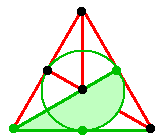



|
 |
The regular map {6,3}(3,5) is shown to the right. We shall show how it is related to the Fano plane.
{6,3}(3,5) is a regular partition of the torus into 21 hexagons. In the image to the right, the torus is portrayed as a hexagon with opposite edges (shown as pink lines) identified.
Its rotational symmetry group is C21:C6, ≅ (C7:C6)×C3. An element of the C21 subgroup moves each hexagon one place to the right, and the C21 subgroup is acted on by the C6 subgroup, an element of which rotates the regular map about the centre of a hexagon. The central C3 fixes every set of three antipodal hexagons, and cycles each such set.

We construct the Fano plane from this regular map as follows. Assign a "point" to each yellow face, an "line" to each green face, and a "face" to each purple face. A "point" lies on a "line" if their hexagons are adjacent. This gives us the figure shown to the left, the Fano plane, which is a finite projective plane with seven points and seven lines. There are three points on each line, and three lines through each point. Any two distinct points define a unique line, and any two distinct lines define a unique point.
Note that the lines of the Fano plane are not like the edges of a regular map: in the Fano plane, each line has three points. Thus the diagram to the left is not an embedding of the Fano plane in the plane, it is only schematic.
The symmetry group of the Fano plane is PSL(2,7), which is isomorphic with PSL(3,2), and has 168 elements. Its subgroups include (C7:C6) and S4.
The Fano plane is not normally considered as having faces, just points and lines. The description of it above does not mention faces. But the process of deriving it from {6,3}(3,5) yields seven points, seven lines, and seven faces.
This derivation tells us which lines and which points are associated with each face. Each face has three lines and three points; any two of these three lines meet in one of the three points, and any two of these three points define one of the three lines. The previous sentence is also true for any permutation of the set (faces, lines, points).
The image of the Fano plane above is a rather unsatisfactory way of showing it in
the plane. What follows is an even less satisfactory way of showing the Fano plane
with its faces, in the plane. There is one diagram for each of the seven faces.
In each diagram, the face itself is tinted in light green (this is almost
meaningless geometrically, as such a face is not bounded by its edges), its
associated lines are coloured green, and its associated points are coloured green.







There are other ways I could have chosen to represent a consistent set of seven
faces, this one seemed the simplest.

For any face, such as the one shown to the left, we find that there are three points which belong to the face's lines but not to the face itself, and three lines which belong to the face's points but not to the face itself. These are all shown in blue. The three blue points lie on one line, shown in red; and the three blue lines pass through one point, shown in black.
If we consider the original mapping, from the three colours of faces of {6,3}(3,5) to the points, lines and faces of the Fano plane, we find that each antipodal set of three faces of {6,3}(3,5) maps to a set of (point, line, face) such as the one shown to the left.
Another image of the Fano plane is shown to the right. It is drawn on a torus. The lines are shown as straight line segments, and do not intersect except at the points. Each line is graded from red through yellow to green, and we see that each point is at the red start of one line, in the orange or yellow mid-region of another line, and at the green end of a third line.
| Orientable | sphere | torus | 2 | 3 | 4 | 5 | 6 |
| Non-orientable | projective plane | 4 | 5 | 6 | 7 |
The images on this page are copyright © 2011 N. Wedd